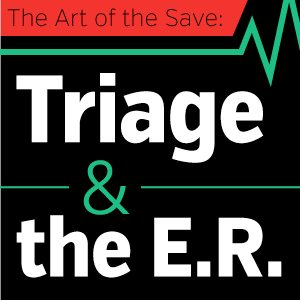Triage is a system that categorizes emergency patients in order to establish vital signs and the course and urgency of treatment.
What is Triage?
Triage: the evaluation and categorization of the sick or wounded when there are insufficient resources for medical care of everyone at once.
The Earliest Days of Triage
Featured Programs
760-710 BC: Greek physician Pikoulis determines arrow and spear wounds have high mortality rates
1745: From this date on, combat surgeons are used
1793: Baron Dominique Larrey (father of triage): put surgical teams near front lines in the Napoleonic wars
1860s: American Civil War: doctors were clueless about triage
1885: The British Army Medical staff formed
1915: World War I. The French concept of combat surgery. Named it trier…to sort out.
Most Common Modern-day Causes of Trauma:
1. Car accident
2. Falls
3. Violence
4. Gunshot wounds
5. Fires
6. Burns
WOW: Trauma is the leading cause of death in the U.S. for people ages 1 to 44, and costs approximately $260 billion annually. Fewer than 8 percent of hospitals in the U.S. have a trauma center.
Established Triage Systems:
START, or Simple Triage and Rapid Treatment
Can be implemented by people without a high level of training.
The categories in START are:
• the deceased, who are beyond help
• the injured who could be helped by immediate transportation
• the injured with less severe injuries whose transport can be delayed
• those with minor injuries not requiring urgent care.
COLOR CODEs:
• Red tags – (immediate) Cannot survive without immediate treatment but who have a chance of survival.
• Yellow tags – (observation) Requires observation (and possible later re-triage). Their condition is stable for the moment and, they are not in immediate danger of death..
• Green tags – (wait) are reserved for the “walking wounded”.
• White tags – (dismiss) minor injuries
• Black tags: – Dead or…those whose injuries are so extensive that they will not be able to survive given the care that is available.
ESI: Emergency Severity Index: patients are rated 1 (most urgent) to 5 (least resource intensive)
Best Emergency Medicine Programs:
1. Johns Hopkins Hospital, Baltimore, Md.
2. Mayo Clinic, Rochester, Minn.
3. Massachusetts General Hospital, Boston, Mass.
4. Cleveland Clinic, Cleveland, Ohio
5. Ronald Reagan UCLA Medical Center, Los Angeles, Cal.
How to Bring a Dead Person back to life (Really…it’s happening)
1. The Auto Pulse: A portable CPR machine, keeps the heart beating. Developed in Australia.
2. Extracorporeal membrane oxygenation (ECMO): An artificial lung outside the body that keeps oxygen and blood flowing to the patient’s brain and vital organs. Australia..and now the U.S. too
3. Cyogenics: The deep freeze (still untested)
4. Adrenaline high: During an operation, a patient’s pulse suddenly stops because of anesthesia, a surgeon injects adrenalin directly into his heart. Sometimes he recovers, usually he dies. OR…#5
5. Cut open the patient’s chest and massage his heart immediately, without waiting to try adrenalin.
OR: Use electricity to bring the body back to life: Dr. Henry Frankenstein (1931) … and many movies thereafter.
6. WATCH OUT FOR: The phenomenon of over-triage: occurs when patients are transferred twice, and discharged from a second facility in less than 24 hours.
TV Doctors
Hollywood and the E.R.:
George Clooney played Doug Ross on the hit TV series, E.R.
Other star TV doctors:
1. Hawkeye Pierce, MASH
2. Bones McCoy, Star Trek
3. Doogie Howser
4. J.D. Dorian, Scrubs
5. Derek Shepherd (McDreamy), Grey’s Anatomy
Related:

